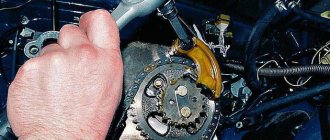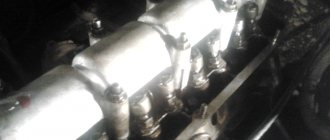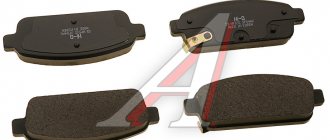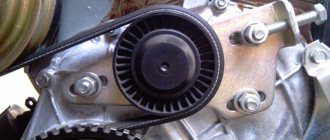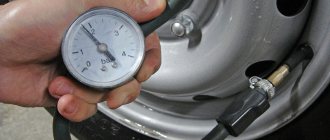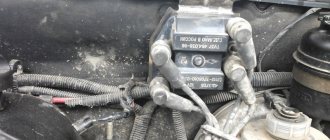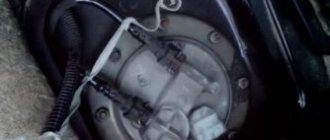Causes of car jerking
The first is a “cold start”, the car’s engine did not have time to warm up from the moment it was started until it started driving, which is typical at low temperatures in winter.
The second reason why the car began to twitch is the driver’s inability to properly operate the manual transmission. A manual transmission requires certain skills; if a driver has only used an automatic transmission, then he is unlikely to use a manual transmission and drive with ease. There is not enough knowledge here that when engaging reverse gear you need to turn the lever “here”.
VAZ 21213 | The car moves jerkily | Niva
In relation to a car, a jerk is a short-term spontaneous change in the engine crankshaft speed, regardless of the position of the gas pedal. In everyday use, as a rule, there are a series of jerks. The extreme case of a jerk is a failure, a noticeable delay in the engine's response to pressing the accelerator pedal.
Conventionally, three types of jerks can be distinguished:
- at the moment of starting movement;
– during acceleration;
– with steady motion, i.e. with the accelerator pedal in constant position.
To determine the causes of jerks when driving a car with an injection engine, special diagnostic equipment is required, so in this case we recommend contacting a car service center that specializes in repairing fuel injection systems. However, as practice shows, in most cases jerking is caused by insufficient fuel pressure in the engine fuel line (“rail”) or a malfunction of the throttle position sensor.
If you have some skills, you can identify the cause of jerking yourself.
Jerking when starting to move
At the moment the movement begins, the limiting case of a jerk often occurs - failure. The most unpleasant sensations are associated precisely with the delay in the engine’s response to pressing the gas pedal. Sometimes the engine even stalls. A jerk occurs at the moment the throttle valve begins to open, when, based on a signal from the throttle position sensor, the ECU determines the moment of transition from idle mode to load mode and must increase the amount of fuel supplied through the injectors. If the pressure in the fuel line is insufficient, even with increasing injection duration, there is not enough fuel for a smooth start.
| To check the fuel pressure, connect a pressure gauge with a measuring limit of 10 kgf/cm2 to a special fitting on the fuel line using a piece of suitable hose. When the engine is running, the pressure in the fuel line must be at least 3 kgf/cm2. |
| NOTE The pressure test fitting has a design similar to a tire valve, with a spool. Therefore, you can use a foot tire pump hose connector to connect the pressure gauge hose. |
The reasons for the decrease in pressure may be:
| – faulty fuel pressure regulator. In addition, failure of the regulator may be caused by a loose fitting of the hose on the fitting of the vacuum chamber of the regulator; |
| – clogged fuel filter; |
| – faulty fuel pump. |
| NOTE For methods of checking and replacing the pressure regulator, fuel filter and fuel pump, see section. 4 “Engine”, in subsection. "Supply system". |
Jerks during acceleration
The cause of jerking during acceleration may be, just as in the previous case (see “Jerking at the moment of starting movement”), insufficient fuel pressure in the fuel line. The ECU, having received a signal from the throttle position sensor about the intensive opening of the throttle at a large angle, strives to maximize the fuel supply, but due to the reduced fuel pressure it is not able to do this. For the reasons for this phenomenon and the method of checking, see “Jerk at the moment of movement starts.”
Jerks during steady motion
Such jerking is most often caused by a malfunction of the ignition system. Diagnostics and repair are necessary (see section 9 “Electrical equipment”). On the way, you can try to do it yourself:
– carefully inspect the engine compartment. Turn off the ignition and check the secure fastening and seating of all wires and connectors at the ignition module and high-voltage wires. Start the engine and listen to its operation - the crackling sound when the high voltage breaks down to ground is weak, but distinct. In complete darkness, the spark during breakdown is clearly visible;
– replace spark plugs regardless of their condition and mileage. Pay attention to the condition of the spark plugs - if they are abnormal, the engine or its systems may need to be repaired.
| A specific cause of jerking during steady motion of a car with an injection engine may be damage to the throttle position sensor. Additional symptoms confirming the malfunction of this sensor are: – uneven operation of the engine at idle; – reduction in maximum engine power. |
The sensor is not dismountable and therefore cannot be repaired. If a sensor malfunction is detected (see section 9 “Electrical equipment”, “Engine control system”), it is replaced as an assembly.
automn.ru
Chevy Niva jerks when driving
When cold, when moving evenly, the car drives jerkily! What could it be? DPDZ new and working, fuel pressure. ramp 4 (when warmed up), compression is the same, spark plug wires are new! 1500 rpm you try to hold the gas pedal, and they jump smoothly 1300-1700, then you press more 3000 rpm they stay well. Once warmed up everything is perfect!
Comments 8
A friend had a problem similar to his Shnive, they changed the module, the spark plugs, the mass air flow sensor, the air sensing sensor, and in the end the problem was in the speed sensor, something like this.
I had the same problem and it turned out to be the ignition module. If it starts to twitch around 3000 rpm, then this is the module
maybe the knock sensor brains rosin
Most likely one of the sensors, I won’t say which one because I don’t know for sure. Drop by for diagnostics if there is no on-board one.
Well, so, the engine has its own operating temperature, at which it works normally, and at a temperature below the operating temperature it starts to twitch, in winter, so at minus 10, try driving as soon as you start it, in first gear, first giving a little gas and then releasing the pedal accelerator, I think it will start to twitch and then stall. At an air temperature of 25-30, you can drive almost immediately. Of course, I may not understand something and I’m muttering about something else here.
A jerk occurs at the moment the throttle valve begins to open, when, based on a signal from the throttle position sensor, the ECU determines the moment of transition from idle mode to load mode and must increase the amount of fuel supplied through the injectors.
The Chevrolet Niva can't handle it. Doesn't develop speed
Jerk at the moment of the beginning of the movement At the moment of the beginning of the movement, the limiting case of a jerk—failure—occurs more often.
Niva Chevrolet repair manual. At the moment the movement begins, the limiting case of a jerk often occurs...
The ECU, having received a signal from the throttle position sensor about the intensive opening of the throttle at a large angle, strives to maximize the fuel supply, but due to the reduced fuel pressure it is not able to do this. The extreme case of a jerk is a failure, a noticeable delay in the response of the Chevy Niva engine to pressing the accelerator pedal.
Jerk at the moment of the beginning of the movement At the moment of the beginning of the movement, the limiting case of a jerk—failure—occurs more often. The extreme case of a jerk is a failure, a noticeable delay in the engine's response to pressing the accelerator pedal. Turn off the ignition and check the secure fastening and seating of all wires and connectors at the ignition module and high-voltage wires.
The reasons for the decrease in pressure may be: In addition, failure of the regulator may be caused by a loose fitting of the hose on the fitting of the vacuum chamber of the regulator; — clogged fuel filter; - faulty fuel pump.
Problems with other elements
Quite often, Opel cars jerk when starting from a stop due to problems with the exhaust gas recirculation valve. This valve is a headache for many Opel owners with Ecotec engines. As a result of the formation of soot on the valve, it may simply become clogged, and then an incomprehensible mixture consisting of fuel, air and waste exhaust gases will enter the combustion chambers. This is fraught with loss of power, increased consumption and, possibly, jerks at start.
Therefore, it is very important to fill only high-quality gasoline, and not save on buying fuel suitable for your engine. The same can be said about oil. Under no circumstances should you fill in oil with the wrong viscosity or additives!
We get rid of vibration and extraneous sounds of the Niva transfer case forever
The characteristic howl and hum of the transfer case on VAZ-21213 cars, alas, is familiar to many owners of such cars. Let’s figure out what is the reason for these problems, and most importantly, how to get rid of them without using “collective farm” methods, such as additional noise reduction.
Content
Understanding the terminology
Let's start by diving into the materiel. Transfer case (TC) is a separate unit of an all-wheel drive vehicle, which provides multi-mode power distribution from the engine to the front and rear axles.
Externally, this is a mechanism located under the bottom of the car, in the body of which a multiplier (divider) is placed in series to obtain an intermediate gear ratio in the transmission and a splitter of one power flow into two. It is with the help of this device and its controls (levers) that go into the vehicle interior that the LADA 4×4 driver selects the all-wheel drive operating mode.
The RK directly connects the front driveshaft and the intermediate shaft (shaft) with the vibration damper to the vehicle’s gearbox. As is probably already clear from the description, this element is connected to the rear axle of the car via a rear propeller shaft.
We study problems and repair methods.
Any car owner definitely doesn’t need to be told why howling and humming are bad. Vibration of the transfer case on a Niva at low speed is quite common. The driver, of course, gradually gets used to many extraneous sounds in the car, but the noise level is high enough to make it impossible to carry on a conversation with passengers while traveling. Due to excessive noise pollution, you will inevitably have to deal with the problem.
Vibration and how to deal with it.
The main reason for the occurrence of unnecessary sounds is multi-frequency vibrations of the components of the transmission. In general, the vibration of the transfer case on a Niva is one of the most common cornerstones that other car owners are forced to fight (or put up with) constantly.
Perhaps this is the most complete set of measures that experienced auto mechanics advise when the transfer case on a Niva hums and vibrates!
Problems with the fuel pump
During diagnostics, you should take into account the conditions under which engine malfunctions occurred - when was the last refueling, air temperature, duration of the trip, time of year. All these factors can play a decisive role in further diagnostics, save the technician from unnecessary work and significantly save time.
For example, problems with the fuel pump can occur if it overheats during a long drive or very high temperatures outside, or when driving at very low speeds. In such cases, vapor locks may form in the pump, which can only be eliminated by cooling the unit. The resulting blockages interfere with the operation of the vacuum fuel pump and prevent it from fully pumping gasoline into the engine. This is one of the most common diseases on similar VAZ models and only replacing the unit will help eradicate it. In the case when a problem arose in what is called “in the open field” and you need to get to the nearest populated area. Regular cold water will come to the rescue. She should water the gas pump or wet a piece of rag, wrap it around the knot and wait a little. After the unit cools down, the car will start and behave absolutely normally.
Remarkable . That in some cases, in the absence of water, urine can be used as a substitute. Yes, this is not a joke! In emergency situations, this method has already helped out many motorists.
Suspension diagnostics.
From time to time, a knocking sound may appear in the front suspension of the Niva Chevrolet. If this problem occurs, it is necessary to immediately diagnose it. It starts with a visual inspection. It is best to do it on a lift or inspection ditch. The wheels must be hung to be able to check the play of the parts. First of all, rubber parts are checked - anthers and oil seals. They should not have visible mechanical damage, cracks or other signs of aging. It is also necessary to check that rubber-metal products do not have one-sided bulging of the mass or its separation from the reinforcement. In this case, it is necessary to immediately replace the parts.
How to prevent this?
The following tips are a little banal, but effective. At a minimum, you need to fill your car with high-quality gasoline with the correct octane number. The instructions for the car must indicate what fuel should be poured into the tank.
This also applies to oil. It is necessary to use only the lubricant recommended by the manufacturer. Taking into account the presence of counterfeit oils on the market and low quality fuel, it is necessary to change oils even more often than the car manufacturer recommends. At a minimum, after 8-9 thousand kilometers the lubricant must be replaced. This will extend the life of the motor.
In general, you need to operate the car carefully. If you put a heavy load on the engine at least once and heat it up to the “red zone” on the thermometer, then problems with the engine can arise constantly. In this case, jerking when starting is far from the worst problem.
At stable high speeds
But the jerking of the car at high speeds is more related to the ignition system.
In a normally operating engine, the ignition system automatically adjusts to certain conditions by changing the ignition timing.
That is, when necessary, the ignition becomes either a little early or late.
A malfunction in the automatic ignition will cause twitching.
Do not forget that the cause of uneven movement will be not only a malfunction of the system, but also the failure of one of its elements.
And these are only the reasons that can arise with the engine, without affecting the transmission.
We narrow down the search for reasons.
In general, you can immediately narrow your search for identifying the causes of car twitching to two engine systems - fuel and ignition, but you should not discount the transmission.
The car is shaking, what should I do?
At the first stage, the machine is diagnosed. Let's say that you have a Niva with a carburetor engine in your garage. Your car already shows signs of “illness” at the first stage of movement. Or the car started moving without any hassle, but when a certain number of revolutions was reached, the engine malfunctioned. All this will not give answers, but only creates questions, because anything can break. In any case, if unstable operation of the car’s power unit is noticed while pressing the accelerator pedal, the first thing you should do is:
- Check air and fuel filters. The supply of air and fuel to form a combustible mixture will be difficult if these elements are heavily contaminated.
- Check the fuel pump. Its incorrect operation leads to unstable fuel supply.
- Check fuel pressure. The supply of the fuel-air mixture under insufficient pressure often leads to jerking of the car. The pressure when the engine is running should not exceed 3 kgf/cm2.
Most of the reasons lie in the car's fuel system.
You shouldn’t write off the ignition system, and sometimes even the transmission can cause discomfort while driving. There can be many reasons. To narrow down your suspicions, measure the conditions during which the car begins to act up.
. To do this, while driving, watch the instrument panel and remember at what moment the uniform movement stopped. Do this several times to confirm that your observation is correct.
The car jerks - causes and solutions
The reasons why a Niva may twitch while driving can be different. And for the rather considerable mileage that I had to cover over several years, not only on the Niva, but also on other domestic cars, I can highlight the problems that made the car twitch when driving.
I want to say right away that the list below will probably not be complete and many VAZ 2121 owners will be able to give their thoughts on this matter. But personally in my practice I have only encountered the following:
- The first and most common case is when you refuel at a gas station with low-quality fuel. There were quite a few such cases in personal practice. I especially remember one when fuel consumption increased from the usual 11 on the highway to 25 and even more. And while driving along the highway, black smoke poured out of the exhaust pipe. It turned out that the local dealer, from whom I refueled with what I thought was gasoline, diluted it almost half with diesel fuel.
- The second reason also relates to the fuel and its composition, or more precisely, to foreign substances in the tank. Often condensation accumulates in it or, again, water gets into the tank with low-quality gasoline. When the carburetor gets enough water, the engine will naturally jerk, since it will not run on water. In this case, it is necessary to pump out all the fuel from the tank and rinse it thoroughly, and check the gasoline for the presence of water - it usually accumulates at the bottom, since it is heavier.
- Burnt contacts of the ignition system, which contribute to misfires and interruptions in engine operation. This problem can be treated either by replacing the contacts or cleaning them. Also, the distributor can break through the ground wires from the contacts, which will also cause unstable engine operation.
- Misfires can also be caused by broken high-voltage wires, faulty spark plugs or even a coil. These malfunctions are treated by replacing failed parts.
That’s probably all that I was able to remember from my personal experience in operating a Niva car and other Zhiguli models. At least there were no other symptoms with my cars. Maybe one of the owners will give their useful advice and problems that arose for them. If you have anything to add, you can add your comments below.
niva-remont.com
The engine idles unevenly: possible reasons
There are quite a few reasons why the engine idles unevenly. Motorists should be aware of them in order to avoid unnecessary waste by solving the problem themselves and doing the repairs themselves. On the other hand, it will also be possible to avoid more serious problems thanks to timely diagnosis.
Causes of uneven engine idling
Experts divide the main reasons for rough idling into two categories:
A malfunction of the air system (intake) can be considered separately, but it is more appropriate to include it in the list of problems with the fuel system. The fact is that both of them are inextricably linked and affect the stability of the power unit in idle mode and under load.
- Fuel-air system and fuel. A poor fuel-air mixture is often the reason why the engine idles rough. Such a “poor” mixture is that there is too little fuel in it and too much air.
Excess air can be sucked in through damage in the line. For example, rubber fuel hoses of poor quality may initially have or acquire microcracks in their walls over time. Poor fixation of the hose also contributes to air leaks at the joints.
A more serious problem can be considered a problem with the idle air valve (also known as the idle air regulator, the secondary air regulator), which is sometimes called the idle air sensor. Owners of carburetor cars also know this part as the “solenoid valve.”
Excess air can also be sucked in through, for example, broken holes in the throttle valve axis on the carburetor. In this case, the problem may not become noticeable immediately: gasoline consumption will gradually increase, and interruptions in idling will appear.
- Poor quality fuel. Because of it, the idle speed also often “floats”. This phenomenon is especially strong when using so-called eco-gasoline. It contains a certain amount of ethanol. Ideally, this not only makes the exhaust gases less toxic, but also helps clean the fuel system.
However, in practice, drivers either deal with counterfeit fuel, manufactured in violation of technology, or use such fuel incorrectly. The fact is that for normal engine operation of the specified “eco” type gasoline in the tank there should be no more than 40-50 percent.
- The fuel pressure regulator (aka low pressure bypass valve) has failed. Its task is to maintain the required fuel pressure while the engine is running in any mode.
This breakdown is indicated not only by uneven engine operation at idle, but also by interruptions if you sharply press the gas pedal, a drop in power, and a strong increase in fuel consumption.
- The injectors are clogged (the channels are coked). Due to poor operation of the injectors, the fuel mixture is of inadequate quality in composition, which leads to disruptions in the operation of the power unit in different modes and increased fuel consumption.
- Air damper malfunction. This is usually a mechanical interference, which also leads to the formation of a poor-quality fuel-air mixture. As already mentioned, this causes the engine to run unevenly.
- The idle speed on the carburetor is not adjusted. In this case, under load the engine will operate normally, but at idle it will sometimes jerk, and at the same time there may even be a slight popping sound in the muffler. A relatively simple problem that you can deal with yourself by tightening the required adjusting screw.
Other elements of the fuel system
Now on to other elements of the fuel system.
Fuel pump.
The next culprit for uneven running may be the fuel pump.
In carburetor cars.
A mechanically driven diaphragm fuel pump is often used here.
So, even a small rupture of the membrane will cause the pump’s performance to drop sharply.
The pump valves may also be to blame. They can easily break the sealing of the device’s chambers, which leads to a drop in fuel supply.
Injection car.
The fuel pump can also cause jerking. On such cars, since the pump is located in the tank, it is electrically driven.
A decrease in device performance leads to the problem described in this article. Here you need to consider a specific case separately.
Now directly about the carburetor.
Because of this, uneven running of the car is also possible. Often such a malfunction occurs due to severe clogging. Debris and dirt can block channels, forget jets, etc.
Sometimes the reason lies in the accelerator pump. A diaphragm accelerator pump is installed on carburetors, the task of which is to increase the fuel supply when the gas pedal is sharply pressed.
But if the membrane is torn, then the accelerator pump will not be able to increase the supply of gasoline, and hence fuel starvation.
Injectors.
For injectors, the fuel injectors are checked next. Violation of their performance leads to jerking of the car.
Injectors need to be cleaned periodically, in principle, like everything else.
Also, in an injection car, the functionality of all sensors involved in the operation of the power system is checked, and then the electronic control unit is checked.
Why does the car jerk when starting from a stop? :: SYL.ru
A machine is a complex mechanism that copes with enormous loads during operation. Therefore, you should not be particularly upset if any node fails or does not work as it should. Any car breaks down - it's only a matter of time. Drivers often complain on forums that their car jerks when starting from a stop. The reasons for this phenomenon may be different. Let's try to figure them out.
Riding style
Speaking about why the car jerks when starting from a stop, we need to start with the obvious. The very first and most obvious reason is a harsh clutch. If you start, add gas and suddenly release the clutch pedal, the car will definitely jerk. Therefore, first of all, you need to try to change your driving style. At a minimum, when starting off, you need to release the clutch pedal very slowly and add a little more gas. However, you shouldn't press the gas pedal too hard.
However, if with an automatic transmission the car jerks when starting, then you won’t be able to change your driving style here, because there is simply no clutch pedal. But even with a manual transmission, the problem may be different. If the car still jerks even when starting smoothly, the problem is clearly not a sudden grip of the clutch discs.
External and internal CV joints
If some suspension parts are poorly secured, then when driving (especially during a sharp start), they can cause the car to jerk. First of all, you need to check the inner and outer CV joints. The inner CV joint transmits rotational energy from the gearbox to the axle shafts and then to the wheels. This element is quite important, and if problems arise with it, it must be changed. This can be done at any service station. Features of failure of the inner CV joint are as follows:
- When destroyed, the inner CV joint becomes loose and can turn when transmitting forces, especially at the start.
- On a straight road without the smallest potholes, the inner CV joint can knock. In this case, it will seem that a dull knock is coming from the wheels.
- Outer CV joints may crunch when turning. If destroyed, they can also cause the car to jerk when starting off.
- Usually, internal CV joints simply wear out and because of this they fail. However, rarely the gearbox can cause a breakdown of this unit. This happens in cases where there is something wrong with the box itself.
- Outer CV joints can break due to impacts or careless driving on a bad road.
If your VAZ car jerks when starting from a stop, then first of all you need to check the CV joints. Often on forums when discussing a similar problem, users point to this particular node. Considering the prevalence of these cars and the cheapness of spare parts, repairing this element is unlikely to be expensive. It is worth noting that a similar problem occurs on the VAZ-2114 car. When starting off, the car jerks, but after replacing the CV joint (“grenade”), the problem disappears.
You will be very lucky if the problem turns out to be in the car's CV joints. These are inexpensive items that are easy to replace. It is much worse if a fault is discovered in the gearbox.
Transmission problem
The gearbox may well be the reason why the car jerks when starting off. However, there should also be other signs of a gearbox malfunction: difficulty shifting all or any one gear, a strange sound from this unit, etc. If this happens on the “mechanics”, then the problem is not so bad. In this case, the box itself can be repaired, and due to the simplicity of its design, repairs will not be so expensive. But if this problem is in the automatic transmission, then this is already serious.
Do they repair gearboxes?
In any case, you will have to go to a service station, where they will examine the car and issue a conclusion. If the automation fails, repairs will be quite expensive. However, if any gear from the mechanism breaks down, the box, in principle, can be disassembled and a separate element replaced, but this is also a rather painstaking and complex procedure, and it costs money.
Note that quite often service stations do not undertake to repair automatic transmissions at all. Often they are simply replaced, but there are craftsmen who agree to restore these units, which allows the owner to save money.
Steering gear
If the steering mechanism is faulty, a similar problem can also occur. If the steering rack has any malfunction, it can create jerks when starting. In this case, the worn parts of the rack are simply replaced, and the problem disappears.
Also, the steering rack tips may have strong play. As a result, during a sharp start or braking, or increase in speed, so-called steering wheel wobble may occur. Bent tie rods result in a sharp jerk of the steering wheel to one side when starting off. This problem requires a quick solution.
Other elements of the steering system, including bushings and silent blocks, can cause the car to knock and jerk when driving. All this applies to the steering mechanism - it can be the reason why, for example, a GAZelle car jerks when starting off. But GAZelle is not the only brand where such breakdowns occur.
Note that problems with the steering mechanism are easier to solve than problems with the automatic transmission. However, the steering mechanism requires urgent repair for the safety of the driver and passengers.
Engine
As sad as it is to admit, a problem with the engine also occurs when such problems occur in the operation of the car. If there is really something wrong with the engine, its speed should jump during sudden jerks. The engine itself can live its own life and respond weakly to the gas pedal.
What could cause the engine to run like this:
- Wear of friction pairs, which requires major repairs. This requires a lot of investment.
- Crankshaft wear. In this case, the car should not only start to move jerkily, but also make noise and knock from the engine.
- Engine coking. In this case, decarbonization will be required, which can be done at a service station.
Note that engine-related problems are the most unpleasant and most often require a large investment.
Fuel system
If the fuel mixture is supplied to the combustion chambers of the engine in the wrong amount, jerking may occur when driving. This can happen if the car owner fills the tank with poor quality fuel or gasoline that the car is not designed for. For example, if a Euro-4 or Euro-5 engine is supplied with fuel with a high sulfur content (92 gasoline), it will wear out quickly. Some injectors may also become clogged, causing the wrong amount of fuel to be delivered. This can lead to jerking at start, but the “symptoms” can be different: loss of power, detonation, increased gas consumption.
Problems with other elements
Quite often, Opel cars jerk when starting from a stop due to problems with the exhaust gas recirculation valve. This valve is a headache for many Opel owners with Ecotec engines. As a result of the formation of soot on the valve, it may simply become clogged, and then an incomprehensible mixture consisting of fuel, air and waste exhaust gases will enter the combustion chambers. This is fraught with loss of power, increased consumption and, possibly, jerks at start.
Therefore, it is very important to fill only high-quality gasoline, and not save on buying fuel suitable for your engine. The same can be said about oil. Under no circumstances should you fill in oil with the wrong viscosity or additives!
"Brains" of the car
A special program decides in what proportion to mix fuel with air and feed it into the combustion chambers. If the program makes an error, then the engine will receive a mixture with an incorrect air/gasoline ratio, which can also cause the car to jerk when starting off. An oversaturated or undersaturated mixture may be fed into the combustion chambers, then a batch of normal mixture may enter the system, after which improper mixing occurs again - all of which can easily cause the car to jerk, both when starting and when driving at speed. This may also be accompanied by popping noises from the exhaust pipe or lack of engine response to the gas pedal.
How to prevent this?
The following tips are a little banal, but effective. At a minimum, you need to fill your car with high-quality gasoline with the correct octane number. The instructions for the car must indicate what fuel should be poured into the tank.
This also applies to oil. It is necessary to use only the lubricant recommended by the manufacturer. Taking into account the presence of counterfeit oils on the market and low quality fuel, it is necessary to change oils even more often than the car manufacturer recommends. At a minimum, after 8-9 thousand kilometers the lubricant must be replaced. This will extend the life of the motor.
In general, you need to operate the car carefully. If you put a heavy load on the engine at least once and heat it up to the “red zone” on the thermometer, then problems with the engine can arise constantly. In this case, jerking when starting is far from the worst problem.
Conclusion
Without the necessary knowledge and tools, it is almost impossible to determine why the car jerks when starting abruptly. Each individual element of a large engine organism can be the reason for this. The above are only the main elements and components that can cause jolts at startup, but there is no guarantee that they are to blame. It cannot be ruled out that the cause of this problem could be elements such as the crankshaft timing sensor or even spark plugs. If at least one spark plug in the cylinder works intermittently, this means that the fuel mixture will not explode in the chamber during one stroke, and during the second, detonation of a large volume of the fuel mixture may occur at once. Naturally, this can cause the car to jerk when driving. The final cause of the malfunction can be determined after diagnosis at a service station.
You should understand that many elements of the engine and transmission can cause jerking at startup. Some of them are quite easy to repair and change, while some require serious intervention.
www.syl.ru
The transfer case shakes in the field when starting off
Please tell me what the reason is. After I crashed a little into the heating line (the sprocket hit the floor of the windshield, it cracked), I backed up and something cracked, and I quietly drove home. The next day I drove a couple of kilometers off-road. After that, when I started to move away in 1st gear, my teeth almost fell out from the shaking, there was a very strong vibration of the transfer case up and down, as if the whole gearbox was about to come out. What is the reason and where to go to fix this problem.
Thanks in advance to everyone who answers.
how he crashed into the front bumper (even the rear bumper was also bent inward).
Where is it located and what is it like?
I probably would have done it differently. I unscrewed the front cover of the front axle housing and visually checked the condition. Half an hour's work.
The procedure is not pleasant (the oil must be drained), and besides, you can only see obvious damage.
To begin with, it’s better to twist everything so that it can spin without disassembling. It will take no more time, but we will check not only the bridge, but also the transfer case and axle shafts.
Maybe a person forgot that the transfer case has 3 lever positions, low-neutral-high, and switches between low and neutral
Thanks everyone for the answers. Now I took 21213 without the engine. And from 2121 to 21213 I moved the engine and gearbox, the transfer case is new. 4 days of repairs and today it started smoking, although the temperature rose very quickly. Tomorrow I will change the pump
.
And the front end really died, most likely the gearbox.
Thank you all so much again.
Yes, for sure, I will change the generator, because it is original from 2121.
What is the easiest way to bleed air from the cooling system? The antifreeze in the radiator does not heat up even an ounce. And the temperature rises to 110 in 5 minutes
That's it, I drove for about 1 km and the plug in the cooling system apparently broke, the temperature is stable at 90. All that remains is to change the generator.
And also, when I did a test drive, the car began to stall when switching from 2nd to 1st gear, while jerking, and while driving it also jerks when you release the gas pedal. And as if the car itself wants to accelerate, you squeeze the gas and it stops twitching. It jerks at low speeds, but not at high speeds. Seems to be clearly explained
Eliminate jerking when the car is moving steadily
If a Chevrolet Niva or Niva 21214 exhibits twitching during stable movement, this most often happens due to problems with the ignition system. You can often hear car owners complaining that they just installed new spark plugs, but the engine has already failed. Detonation can occur even with new spark plugs due to incompatibility with the engine. If the spark plug fails, then the fuel will not burn completely, and breakdowns will begin in the operation of the power unit.
Checking the spark plugs is quite easy. The first thing you need to do is:
- Check the level of gaps on the unscrewed spark plugs. Check for any irregularities in the sparking process.
- A working spark plug produces a dark blue spark.
- If there is black carbon on the spark plug, then the problem may lie in a faulty ignition or faulty mixture formation.
If checking the spark plugs does not bring any results, you should check all wiring for oxidation and breakdowns. Don't forget about the coil and toggle switch. All elements of the ignition system, as in the case of a problem in the power system, are thoroughly inspected and checked for correct operation.
What to do if the engine fails?
Every experienced car enthusiast knows that if the engine stalls, it means one of the cylinders is not working. This malfunction needs to be fixed urgently, because operating the machine in this mode leads to a decrease in power and excessive fuel consumption. If the cause is not identified, expensive repairs will soon be required. Such a malfunction may appear on a Chevrolet Niva car for several reasons. Experienced craftsmen divide them into four categories: there is nothing to ignite the fuel-air mixture, a lack or excess of air supply to the combustion chamber, or low compression in the cylinder.
“Nothing to set on fire”
The most common reason is a malfunction in the ignition system, which is responsible for the timely supply of a spark and ignition in the cylinders.
If one cylinder does not work, one should assume the failure of one of the chain links:
- The spark plug has failed - unscrew it and inspect it. If you see heavy carbon deposits, clean it with fine sandpaper and heat it, or replace the spark plug with a new one.
- Failure of the ignition coil - a diagnostician can determine this malfunction. The only way to get the engine working is by replacing the spare part.
- Damage to high-voltage wires - according to regulations, they must be changed every 30-40 thousand km. It is easy to notice a breakdown by the sound or spark while the engine is running.
If your spark plugs regularly become dirty, it is advisable to visit a diagnostician to identify the cause.
Not enough air - engine stalls
When an insufficient amount of air enters the combustion chamber, a rich mixture is obtained, which may not always or completely burn out in one of the cylinders. This subsequently leads to unstable engine operation.
There are three possible reasons:
- The air filter is clogged - remove the cover and inspect its working surface. If heavily soiled, replace the element.
- The idle air control or throttle sensor has failed - only computer diagnostics will show this malfunction. If you have spare parts available, install them instead of the standard ones.
- Clogged throttle valve - remove the intake manifold and inspect the throttle valve. If there is dirt and oil on it, this will cause it to partially jam. Remove the entire assembly and clean it with a special liquid.
There is a plastic pipe in the intake manifold of the Niva Chevrolet engine. Often it falls off and severely cuts off the air supply, causing tripping.
There is a lot of air, so the engine is running
If there is air leakage, the computer “does not understand” how much the throttle valve needs to be opened. In this mode, the accelerator begins to work unstably.
This breakdown can be caused by three reasons:
- Damage to the air pipes or vacuum brake booster - carefully inspect the elements. If you find cracks, replace the hoses with new ones, tightening the clamps securely.
- The mass air flow sensor has failed - computer diagnostics can show wear of the mass air flow sensor. When replacing it, the speed is equalized and power returns.
- Intake manifold damage - inspect all gaskets and housing for cracks. If necessary, spray carburetor or throttle cleaning fluid, so you will immediately notice air leaks when the speed is equalized.
Impact of jerks on the car
Whether jerking the car is beneficial or harmful is a rhetorical question. It’s the same as poking a person with a knife and asking if your health is improving. Any kind of jerking of the car is harmful, be it just a jolt when driving or a consequence of changing gears.
The main impact falls on the transmission unit and the engine part. First of all, the load on moving elements (bearings, switches, gears) increases. Each impact can deform, leave a crack or completely break any of these elements. Repairs can take a long time and cost the car owner a significant amount of money. That is why it is important to initially determine the reason why the car began to twitch and eradicate it.
